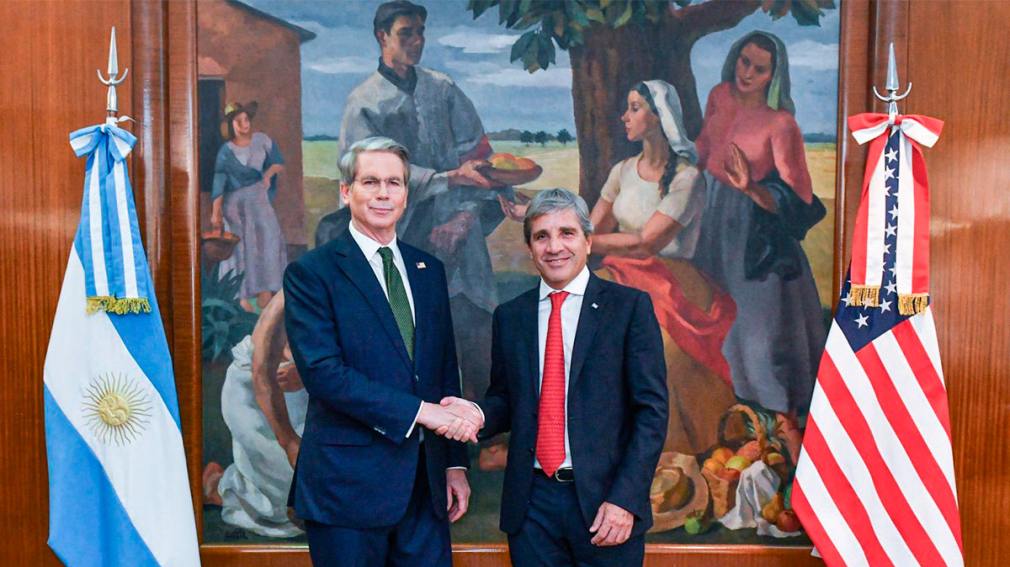
Just 2 days after the election, the pressure on the dollar returned and the wholesaler was only $20 from the intervention band this Tuesday. While the victory of milleism triggers a shock of expectations in the markets that puts downward pressure on the dollar with the prospect of reforms and more benefits for big capital, structural factors of the economy generate the opposite effect.
The non-accumulation and scarcity of Central reserves, added to the low probability of supply from the private sector in a month of low settlement and with agricultural dollars already squandered in the electoral campaign, generates upward pressure. Also with a (near) horizon of unpayable debt maturities, increased with Caputo’s financial cycle as a “policy” to keep the dollar at bay.
In this sense, after spending “every last dollar” and losing in the PBA election, Milei and Caputo went to look for a lifeline with Donald Trump and Scott Bessent. Thus, the United States Treasury itself intervened with a bailout for the Government, in the middle of the elections and took the reins of the economy.
This Tuesday the whereabouts of the pesos that the United States received in exchange for the intervention dollars were revealed. Based on the Weekly Balance report published by the Central Bank, the consulting firm 1816 discovered a jump in the stock of “Bills and Notes issued in National Currency” of the Central Bank, based on injections from the North American Treasury.
“The stocks stopped coinciding after Bessent announced the first US intervention in the Peso and we take this as practically a confirmation that the Pesos of the North American Treasury are outside the banking system and in Letters issued by the BCRA,” says the 1816 report.
Thus a difference arises in the Central Bank’s balance that jumps from $293 billion to $3.05 billion at the close of Thursday the 23rd, more than 10 times. “The difference, of $2.75 trillion, which is equivalent to USD 1,855 million, is explained, as we believe, by the Pesos that the United States had in the Central Bank at the close of Thursday. Those $2.75 trillion are those that appeared for the same day in the OTHER liabilities line in Pesos of the Daily Monetary Report (on that day the BCRA neither took Pesos simultaneously nor delivered Pesos in the REPO wheel at the end of the day, so We thought that everything was explained by the US stock.) Considering the data on OTHER liabilities from Friday before the election, all the numbers are in line with what we estimated at the end of last week: Bessent would have bought Pesos for around USD 2.1 billion,” the report defines.
In conclusion, the consulting firm 1816 added that so that the North American Treasury can eventually make a profit from its bet on the peso, If the US did not have “dual” bills in its possession (with coverage against devaluation), “it would need to maintain the floating scheme between bands.” Thus, Trump will pressure to maintain this gang scheme to guarantee his carry tradethat is, making a difference in rates and converting the pesos (plus the profit) with a cheap dollar. Imperialist plunder in the open.
Debt or devaluation: a false dichotomy
The government seeks to establish that it can keep the dollar contained, emboldened by the electoral victory, that the financial problems would only be temporary and that it is avoiding a drastic devaluation that would be the only alternative. But that is a false dichotomy, a trap for the vast majority who would always lose.
A backward dollar implies a slowed economy, liquefied salaries, job destruction and increasingly suffocating debt. A devaluation, for its part, would mean a direct blow to the popular sectors, transferring the adjustment via inflation.
The “order” that Milei and Caputo promise is built on submission to the designs of imperialism. Trump and Bessent did not come to help: they came to guarantee that Argentina continues to be a subordinate country and source of business for concentrated capital from the north.
While investment funds make million-dollar profits with the carry trade and the government kneels before Washington, the consequences are paid by the working people. The Central Bank’s reserves evaporate to support a scheme that only benefits speculators.
The increase in external debt is not a solution, but a trap. It reinforces dependency and weakens sovereignty. Therefore, the only real solution is not to choose between more debt or more adjustment, but to break with both paths as proposed by the Left Front.
An alternative is needed that recovers control of resources and foreign trade, that nationalizes the banks under the control of the workers and that democratically plans the economy based on social needs, not the profits of a handful of businessmen and Trump’s interests in the region.
Source: www.laizquierdadiario.com

